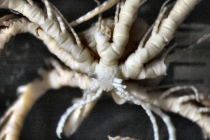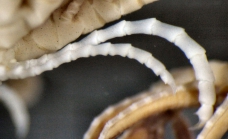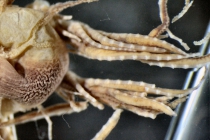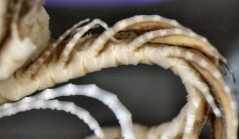
| About | | Search taxa | | Taxon tree | | Search literature | | Checklist | | Stats | | Log in |
WoRMS taxon detailsDorometra parvicirra (Carpenter, 1888)
213556 (urn:lsid:marinespecies.org:taxname:213556)
accepted
Species
Antedon parvicirra Carpenter, 1888 · unaccepted (basionym)
Iridometra parvicirra (Carpenter, 1888) · unaccepted (synonym)
Iridometra scita AH Clark, 1908 · unaccepted (synonym)
marine,
(of Antedon parvicirra Carpenter, 1888) Carpenter, P. H. (1888). Report on the Crinoidea collected during the voyage of H.M.S. Challenger, during the years 1873-76. Part II. The Comatulae. <em>Reports of the Scientific Results of the Voyage of H.M.S. Challenger, Zoology.</em> 26 (part 60): i-x, 1-402, pl. 1-70., available online at http://www.19thcenturyscience.org/HMSC/HMSC-Reports/Zool-60/README.htm [details]
Distribution Notojima, Ishikawa Prefecture; E coast of Magari; Kerama Is., Okinawa Prefecture, Japan. Depth range: (?1)2-40 m.
Distribution Notojima, Ishikawa Prefecture; E coast of Magari; Kerama Is., Okinawa Prefecture, Japan. Depth range: (?1)2-40 m. [details] Distribution Also distributed in East Indies, north Australia, Philippines, China and south Japan (Clark & Rowe (1971)); Australia (Rowe...
Distribution Also distributed in East Indies, north Australia, Philippines, China and south Japan (Clark & Rowe (1971)); Australia (Rowe & Gates, 1995). Ecology: benthic, inshore, continental shelf, suspension feeder. General distribution: tropical, west Pacific Ocean, depth range 0-164 m. (Rowe & Gates, 1995). [details]
Messing, C.; Gondim, A.I.; Markello, K.; Poatskievick Pierezan, B.; Taylor, K.; Eléaume, M. (2025). World List of Crinoidea. Dorometra parvicirra (Carpenter, 1888). Accessed through: World Register of Marine Species at: https://www.marinespecies.org/aphia.php?p=taxdetails&id=213556 on 2025-05-10
Date action by 2000-09-05 11:27:26Z created Garcia, Maria 2000-09-26 07:19:20Z changed Garcia, Maria
Nomenclatureoriginal description
(of Antedon parvicirra Carpenter, 1888) Carpenter, P. H. (1888). Report on the Crinoidea collected during the voyage of H.M.S. Challenger, during the years 1873-76. Part II. The Comatulae. <em>Reports of the Scientific Results of the Voyage of H.M.S. Challenger, Zoology.</em> 26 (part 60): i-x, 1-402, pl. 1-70., available online at http://www.19thcenturyscience.org/HMSC/HMSC-Reports/Zool-60/README.htm [details] original description (of Iridometra scita AH Clark, 1908) Clark, A. H. (1908). Preliminary notice of a collection of recent crinoids from the Philippine Islands. <em>Smithsonian Miscellaneous Collection, Quarterly Issue.</em> 52(2):199-234. [details] basis of record Clark, A. H., Clark, A. M. (1967). A monograph of the existing crinoids. <em>Bulletin of the United States National Museum.</em> (82): 1-860. [details] new combination reference Clark, A. H. (1917). A revision of the crinoid family Antedonidae, with the diagnoses of nine new genera. <em>Journal of the Washington Academy of Science.</em> 7(5): 127-131., available online at https://biodiversitylibrary.org/page/2016564 [details] Otheradditional source
Rowe, F. W. E.; Gates, J. (1995). Echinodermata. <em>In: Wells, A.; Houston, W.W.K. (Ed.) Zoological catalogue of Australia, 33. CSIRO: Melbourne. ISBN 0-643-05696-3. XIII.</em> 510 pp. [details]
additional source Kogo I (1998) Crinoids from Japan and its adjacent waters. Special Publications from Osaka Museum of Natural History 30:1-148. [details]  Present Present  Present in aphia/obis/gbif/idigbio Present in aphia/obis/gbif/idigbio  Inaccurate Inaccurate  Introduced: alien Introduced: alien  Containing type locality Containing type locality
From editor or global species database
Diagnosis Large, robust Dorometra with P2 (13 to at least 14 pinnulars) intermediate in size and in number of pinnulars between P1 (10-15 pinnulars) and P3 (17-19 pinnulars). Cirri not especially slender, with up to 17 cirrals; longest cirrals not more than twice as long as width of expanded ends. Arms 50-60 mm long. [details]Distribution Notojima, Ishikawa Prefecture; E coast of Magari; Kerama Is., Okinawa Prefecture, Japan. Depth range: (?1)2-40 m. [details] Ecology At Nagada Harbor, Madang, Papua New Guinea: among branches of the coral Acrhelia horrescens on a sandy/muddy bottom adjacent to an inshore lagoonal island in 10-12 m. [details] Holotype Natural History Museum, London (England) 1888.11.9.62. Type locality: Challenger station 208, E of Panay, Philippines (Clark AH & Clark AM, 1967; Rowe & Gates, 1995). [details] Unreviewed
Distribution Also distributed in East Indies, north Australia, Philippines, China and south Japan (Clark & Rowe (1971)); Australia (Rowe & Gates, 1995).Ecology: benthic, inshore, continental shelf, suspension feeder. General distribution: tropical, west Pacific Ocean, depth range 0-164 m. (Rowe & Gates, 1995). [details]
To Biodiversity Heritage Library (12 publications) (from synonym Antedon parvicirra Carpenter, 1888)
To Biodiversity Heritage Library (13 publications) To Biodiversity Heritage Library (7 publications) (from synonym Iridometra scita AH Clark, 1908) To Biological Information System for Marine Life (BISMaL) To Biological Information System for Marine Life (BISMaL) (from synonym Antedon parvicirra Carpenter, 1888) To Biological Information System for Marine Life (BISMaL) (from synonym Iridometra parvicirra (Carpenter, 1888)) To European Nucleotide Archive, ENA (Dorometra parvicirra) To GenBank (18 nucleotides; 7 proteins) To GenBank (18 nucleotides; 7 proteins) (from synonym Antedon parvicirra Carpenter, 1888) To USNM Invertebrate Zoology Echinodermata Collection (11 records) To USNM Invertebrate Zoology Echinodermata Collection (Holotype USNM 25451) (from synonym Iridometra scita AH Clark, 1908) |






